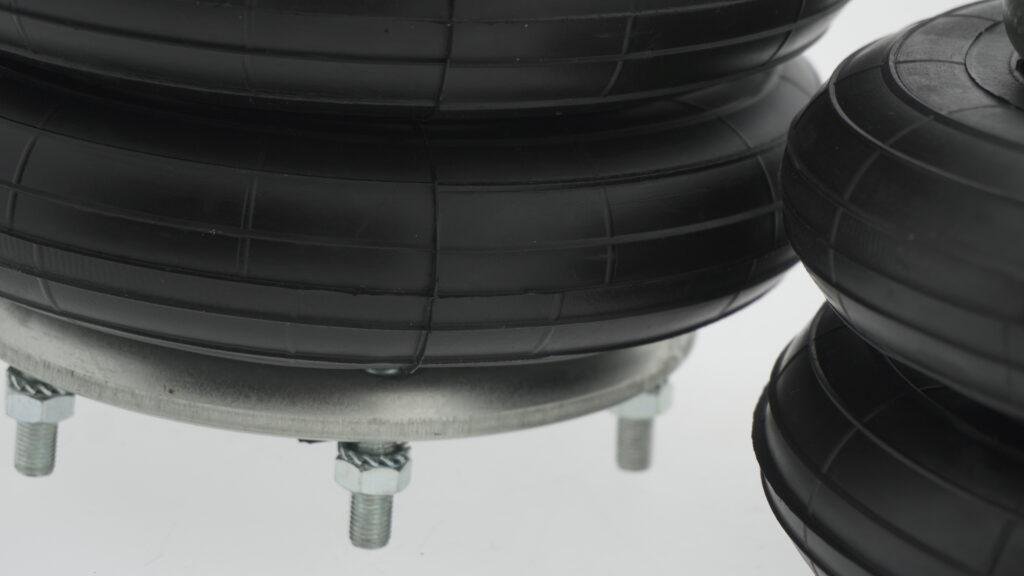
The operational environment significantly influences the behavior, longevity, and reliability of air springs. In this article, we analyze the impact of environmental factors on air springs performance, focusing on real-world industrial conditions. Exposure to temperature extremes, moisture, chemicals, dust, and UV radiation can degrade materials and reduce functionality. Understanding these factors allows engineers to select appropriate materials, mounting strategies, and protective measures. Our goal is to help users extend service life, minimize failure risks, and maintain consistent isolation and actuation performance. Proper environmental adaptation transforms air springs from a standard component into a long-term, maintenance-free solution in challenging conditions.
Temperature Extremes Alter Material Behavior
One of the most critical environmental factors on air springs performance is temperature. At low temperatures, rubber becomes stiffer, reducing flexibility and response time. Most standard natural rubber compounds operate effectively between -40°C and +70°C. For colder or hotter environments, EPDM, CIIR, or NBR compounds are preferred. High temperatures accelerate aging, hardening the rubber and reducing elasticity. This leads to reduced stroke length and eventual cracking. Thermal cycling—rapid fluctuations between hot and cold—can separate plies or weaken adhesive bonds. To counteract these issues, engineers must select elastomers matched to temperature profiles and avoid mounting near heat sources without thermal barriers.
Moisture and Humidity Accelerate Corrosion
Another key environmental factor on air springs performance is humidity. Water exposure can lead to corrosion of galvanized steel parts and accelerate the breakdown of unprotected rubber. Applications in food processing, marine environments, or outdoor installations must use AISI-304 stainless steel or AISI-316L components. When compressed air contains moisture, it can collect inside the bellow, increasing oxidation risk. Drain valves, air dryers, or moisture traps prevent internal damage. For bellows exposed to constant wash-down or splash zones, protective coatings or external covers should be applied. Extended contact with water requires both chemical-resistant rubber compounds and non-corrosive structural components.
Chemical Exposure Requires Material Compatibility
In industrial settings, air springs may be exposed to oils, solvents, acids, and other corrosive substances. The wrong material selection under such exposure leads to swelling, blistering, and loss of elasticity. NBR resists oils and fuels, making it suitable for hydraulic environments. CIIR withstands acids and oxidizing agents. EPDM is ideal for alkaline or steam-rich areas. Without chemical compatibility, isolation performance drops quickly, and failure can occur unexpectedly. Proper compatibility extends both the mechanical and chemical lifecycle of the air spring. Design teams should assess all potential chemical contacts, including lubricants, degreasers, and airborne vapors, to make informed material choices.
Dust, Debris, and Abrasive Particles Cause Mechanical Damage
Air springs in dusty environments face another challenge: abrasion. Grit and fine particles can wear through the rubber skin, especially when combined with vibration. In foundries, mines, or concrete plants, airborne silica and metallic particles accelerate wear. Bellows must be protected with shields or bellows boots. Frequent cleaning prevents accumulation of particles between convolutions. Additionally, exposure to metal chips or tools during installation may cause punctures. Pre-installation cleanliness is essential. In environments with fine dust, choose rubber compounds with enhanced abrasion resistance and inspect frequently for surface damage that may lead to pressure loss or mechanical failure.
Ozone and UV Exposure Cause Surface Degradation
Outdoor exposure presents long-term issues for air springs, especially related to ozone and UV radiation. These elements degrade rubber compounds by breaking molecular chains at the surface. This results in cracks, chalking, and weakening. EPDM and chloroprene (CR) offer excellent resistance to ozone and UV damage. However, even with suitable elastomers, prolonged direct sunlight or electrical discharge equipment nearby accelerates degradation. Air springs should be installed away from ozone-generating devices and protected with covers or housing enclosures in sunlit installations. Surface damage may seem cosmetic at first but eventually leads to structural weakening and failure under load or pressure.
Mechanical Vibrations and Shock Loads
While air springs are designed to isolate vibration, certain installations expose them to shock loads or resonant frequencies that exceed their design. Repetitive impact, incorrect alignment, or inadequate preload can degrade material prematurely. Excess motion causes internal ply delamination and fatigue cracking. Multi-convolution bellows handle these conditions better due to more even stress distribution. Avoiding metal-to-metal contact between mounting surfaces prevents localized vibration transfer. If exposed to shocks or alternating loads, four-ply constructions provide added durability. Engineers must ensure that dynamic load factors are calculated and that air springs are not undersized for actual operating conditions.
Storage Conditions Affect Shelf Life
Even before installation, environmental factors affect air springs performance. Storage conditions must be controlled to prevent premature aging. Rubber degrades in high heat, humidity, and ozone exposure. ISO 2230 outlines best practices, recommending storage in cool, dark, and dry locations. Avoid placing air springs near motors, fluorescent lights, or transformers that emit ozone. Never store bellows compressed or bent, as this creates permanent deformation. Proper inventory rotation and storage control ensure that air springs maintain full flexibility and pressure capacity when finally installed. Even unused parts can fail early if stored improperly for long durations.
Mitigation Strategies for Harsh Environments
Engineers can improve performance by adapting air springs to their operating environment. Strategies include selecting suitable rubber compounds, using stainless steel hardware, installing protective boots, and adjusting mounting design. For aggressive chemicals or abrasive dust, consider isolating the bellow from direct exposure. If vibration or temperature are key concerns, tune pressure and stroke to avoid overload. Use external enclosures or shielding where long-term exposure cannot be avoided. Documenting the environmental profile during the design phase ensures compatibility and avoids premature wear. Long-lasting performance begins with proactive protection against these real-world threats.
